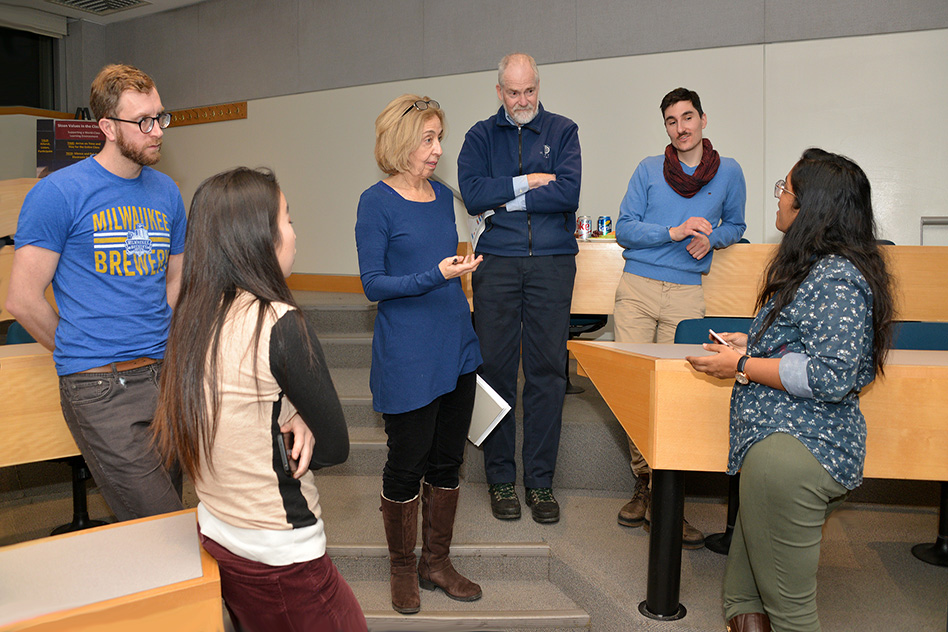
On January 20 a new administration entered the White House determined to cut spending on climate change and environmental protection programs, and reduce restrictions on greenhouse gas emissions that contribute to global warming. To help the MIT community better understand what’s at stake, graduate students with the MIT Joint Program on the Science and Policy of Global Change presented seven courses on climate science and policy during the 2017 MIT Independent Activities Period. Held January 30-February 2 and entitled “Climate Science and Policy: Now more than ever!” the series provided a fast-paced, accessible introduction to the Earth’s climate system and the links between scientific and societal aspects of climate change.
Climate Science
Justin Bandoro, a graduate student in the Department of Earth, Atmospheric and Planetary Sciences Program in Atmospheres, Oceans and Climate, presented a two-part introduction to climate science. In Climate Science 101: Fundamentals, he reviewed the history of the field and provided a broad overview of the physics of the climate system. Topics included the structure and composition of the atmosphere; the Earth’s energy budget; variability in the climate system; and the impact of greenhouse gas emissions on the climate. In Climate Science 102: Modeling Systems, Bandoro focused on how the global climate system responds to natural and human-caused forcings and feedbacks, and how models can detect and attribute observed changes in the climate system to human activity.
Christoph Tries, a master’s student in the Technology and Policy Program (TPP), led a session on the role of uncertainty in climate projections and impacts. In Embracing Uncertainty: How our society deals with not knowing, and what we can do to prepare for climate change, he examined the substantial yet underestimated role which uncertainty plays in our economy, politics and science. In particular, he described the main sources of uncertainty in climate projections and how they translate into uncertainty in climate impacts. The course concluded with suggestions on how to adequately adapt to climate change and communicate uncertainty issues to the public.
“We have different conceptions and classifications of uncertainty,” said Tries. “Even among the experts there’s no agreement, and there is a push to have a coherent methodology for quantifying uncertainty.”
Climate Policy
Four Joint Program courses explored climate policy design, carbon pricing and global climate negotiations. In Economics & Policy of Climate Change: How would you design a good climate policy? Minghao Qiu, a graduate student at the Institute for Data, Systems and Society (IDSS), introduced basic concepts in environmental economics and policy, and defined and weighed the pros and cons of various climate change mitigation policy options, including government regulations, cap‑and‑trade and a carbon tax.
“We use cost-benefit analysis to evaluate whether a climate policy is good or not,” said Qiu. “We calculate the benefit of a climate policy such as a carbon tax using the social cost of carbon; the cost of the policy can be captured using a carbon dioxide abatement cost curve.”
Arun Singh and Michael Davidson presented International Climate Governance & the U.S. Role:
How do global climate negotiations work? Singh, a master’s student in the TPP, outlined the 25-year history of international climate negotiations under the U.N. Framework Convention on Climate Change, what the Paris Agreement achieved, and next steps in its implementation. Davidson, a PhD student in engineering systems at the IDSS, examined the role of the U.S, the world’s second largest emitter of carbon dioxide, in shaping global climate policy; the successes and failures of U.S. climate policy; and what changes we might expect in the coming years.
In Can Carbon Pricing Solve Climate Change? Lessons from climate policy efforts around the world, Emil Dimantchev, a master’s student in the TPP, unpacked one of the foremost proposed solutions to the problem of climate change: putting a price on carbon. Drawing on 20 years of government experiments with different forms of carbon pricing, from carbon taxes to cap-and-trade systems and other carbon markets, Dimantchev explained how a carbon price brought down a government, why politicians and economists are diametrically opposed on the idea, and what role carbon pricing could play in formulating effective climate policy.
“Carbon pricing is difficult, so we should think of it as a journey and be open to the idea of accepting concessions,” said Dimantchev, who previously served as a senior carbon market analyst at Thomson Reuters. “It’s going to be a slow and incremental process. If we want our research to be relevant and our strategies to be successful, we should account for political feasibility.”
The Joint Program IAP course series concluded with an interactive group project, World Climate Negotiations, a mock international climate negotiation in which participating groups represented regions of the world with various goals for mitigation, adaptation and economic growth. The computer simulation C-ROADS (developed by MIT Sloan School of Management Professor John Sterman) was used to assess the outcomes of the mock negotiation in real-time. The project was based on Climate Interactive’s World Climate Project.
PowerPoint slides and videos (coming soon) of the Joint Program’s 2017 IAP courses are now available online.
Photo: The Joint Program IAP course series concluded with a mock international climate negotiation in which participating groups represented regions of the world with various goals for mitigation, adaptation and economic growth. (Photo by Dimonika Bray)

